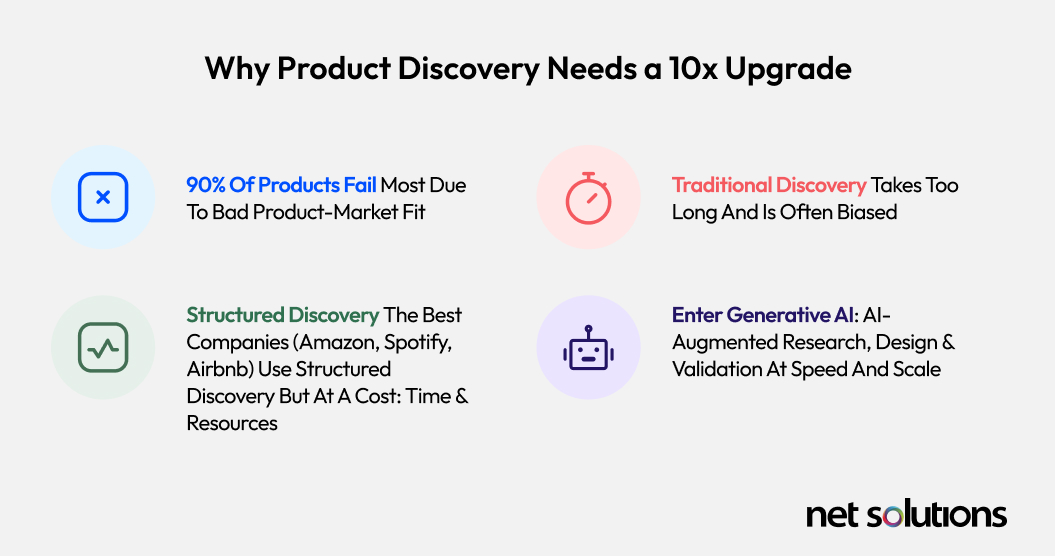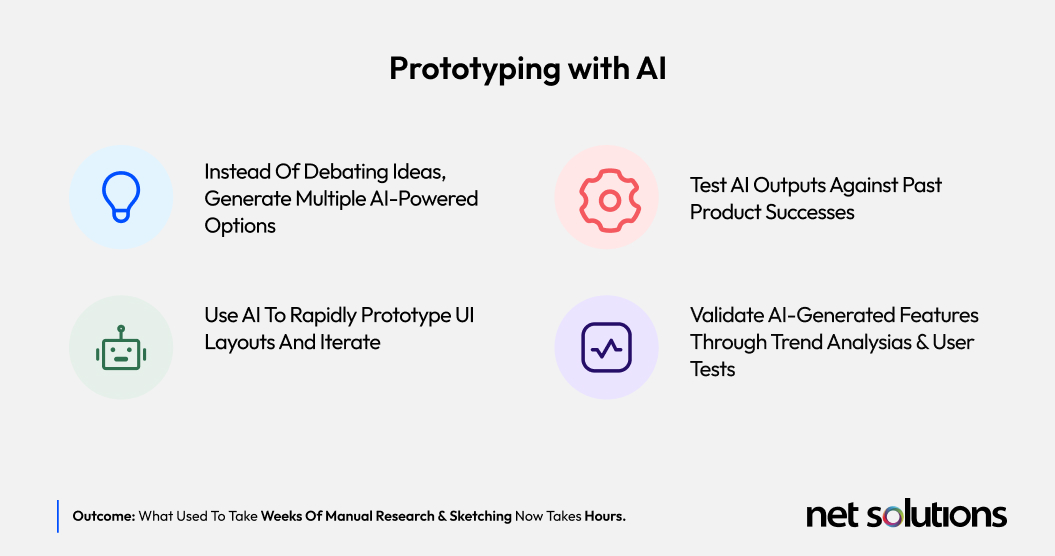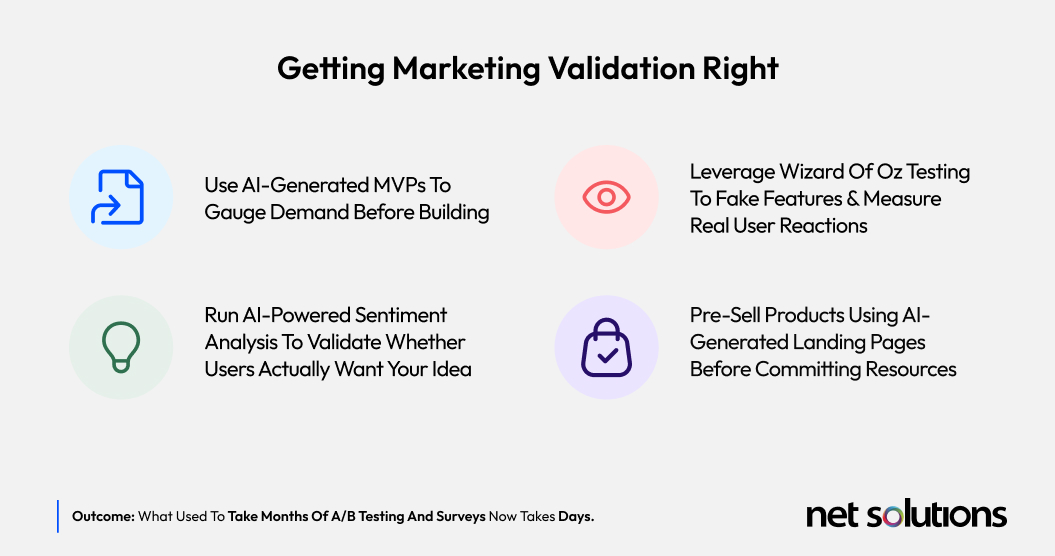Building a successful product means doing far more than simply coding features and hoping customers show up. It’s about deeply understanding the market, pinpointing genuine customer needs, and creating solutions that truly solve real-world problems. Yet, for many teams, this essential product discovery process can be slow, biased, and prone to guesswork, leading to costly missteps.
That’s where Gen AI enters the picture. By swiftly aggregating and analyzing user feedback, automating labor-intensive tasks, and enabling rapid experimentation, AI empowers product leaders to discover hidden opportunities and avoid building features nobody wants.
In the following blog, we present a candid conversation between Joseph Jude (JJ), Chief Technology Officer at Net Solutions, and Saumya Bhatnagar, Co-Founder and CPO at Involve AI, as they explore practical ways to integrate AI into your product discovery journey. If you ever wished you could bring fresh ideas to life faster and eliminate wasteful guesswork, you won’t want to miss their insights.
JJ: Hello, everyone! Thanks for joining us today. I’m Joseph Jude. Folks call me JJ, and I’m Chief Technology Officer at Net Solutions. I’ve spent decades helping brands build cutting-edge digital experiences. Creating something people want is the holy grail for any product leader. But let’s face it—so many products fail, not because they aren’t well-built, but because nobody wants them. I have the battle scars to prove it. In a different avatar, I built a cybersecurity product with excellent features that still flopped in the market.
So, how do we avoid that fate? And can Gen AI help product leaders differentiate faster? I’m thrilled to have Saumya Bhatnagar talk about that with me. Saumya is a Forbes 30 Under 30 alum, “Stevie Gold Entrepreneur of the Year,” and recognized among the 50 most powerful women in tech. She’s co-founder and CPO at Involve AI, holds an MS in Computer Science from UC Santa Cruz, and is a champion for women in tech.
JJ: Saumya, let’s dive right in. Why do you believe product discovery needs a “10x upgrade,” and how is Gen AI shaping that transformation?

Why Product Discovery Needs a 10x Upgrade
Saumya: Thanks for having me, JJ. You’re right—product leaders are constantly trying to ensure they hit the right product-market fit, but the problem is that the market keeps changing. Traditional discovery methods can be clunky. They rely heavily on manual data gathering, user interviews, and sometimes many opinions from whoever is loudest in the room.
That’s where I see Gen AI coming in. It’s a force multiplier that can compress weeks of user research into hours. It can process massive amounts of data—support tickets, surveys, app reviews, social media chatter—and surface genuine insights. That means you can validate user needs faster and more objectively. But the goal isn’t to replace your critical thinking; it’s to boost it.
Using AI for Rapid User Research
JJ: Right, so you’re essentially saying we can gather far more precise user feedback, far more quickly. Let’s talk about that. Traditional discovery is so time-consuming—finding users, scheduling interviews, transcribing, and synthesizing. How do you see AI speeding that up?
Saumya: AI-powered pipelines are key. Imagine hooking up all your organization’s different data streams—support tickets, feedback forms, analytics dashboards, chat logs, and even Reddit conversations about your product or domain. Once you consolidate that data, Gen AI excels at clustering user concerns, identifying recurring themes, and ranking pain points. It can even highlight emerging problems before they balloon into something bigger.
JJ: I love that. Data is scattered in organizations, so building a robust pipeline gives AI a chance to see the bigger picture. You also mentioned “synthetic interviews.” That sounds fascinating. How does that work?
Saumya: Synthetic interviews let the AI role-play as your ideal customer persona—your ICP. You say, “You are a VP of Sales at a mid-sized tech company; here are your pains, budgets, goals. Now let me ask you some questions.” It’s a good way to brainstorm user scenarios and pain points. Of course, you still do actual interviews, but synthetic ones help you figure out what to ask or clarify in actual interviews. They’re a huge time saver.
Fast Hypothesis & Prototyping
JJ: Let’s shift gears to ideation and prototyping. We’ve had those legendary brainstorming sessions where sticky notes cover the walls. They’re fun, but they often get dominated by a few voices, and sifting through all that can be chaotic. How does AI tackle this more efficiently?
Saumya: Exactly—those endless sticky-note sessions can be draining and prone to bias. Instead, AI can generate quick “problem-solution trees” based on all the user feedback you fed it. So, you start from a place of structure: here’s the main problem, possible sub-problems, and multiple solution pathways. It’s data-backed, not just based on who shouts the loudest.
JJ: That’s powerful. But what if we end up with generic ideas because everyone’s feeding the same data into ChatGPT?
Saumya: That’s where your internal data—and your team’s context—becomes your secret sauce. The more nuanced information you feed the AI (user feedback, specific personas, known issues), the more unique the solutions. Then, you add your human creativity on top. AI is here to clear the grunt work and highlight patterns quickly; it can’t replace your real-world expertise or your designers’ creativity.

Rapid Wireframes & MVP Testing
JJ: You also touched on prototyping tools like Uizard and Lovable. You’re saying we can spin up wireframes in hours, even link them into a clickable mockup, and hand them off for user testing—without writing a line of code?
Saumya: Exactly. That’s the beauty of it. You can create a functioning front end with minimal design effort, then run a test with real or potential users. Some call it the “Wizard of Oz” approach—fake the functionality behind the scenes so you can see if people even care to use it. If they’re not interested, you can kill the feature early, no engineering effort wasted.
JJ: That’s huge. It frees up our engineers for critical tasks like fixing those pesky concurrency issues or paying down technical debt. So, once we have these quick prototypes, how do we get real feedback?
Saumya: You can share the clickable prototypes with small user cohorts or set up a quick landing page or ad campaign to gauge interest. Collect feedback, see if people are actually hitting “sign up” or “add to cart,” and if there’s a real pull. AI can analyze the feedback in real time—“people are confused at step three” or “85% of testers say the color scheme is too busy.”
Market Validation & Competitive Edge
JJ: One question that popped up from our audience earlier was, “How can we spot emerging trends before the competition does?” Everyone’s using AI, so how do we maintain a competitive edge?
Saumya: The key is the frequency of iteration. Before Gen AI, you might do a market analysis once a year—or once in a blue moon. Now you can do a mini “competition check” monthly or even weekly. AI can scan relevant forums, articles, and competitor pages. It won’t take more than 20 minutes to gather fresh insights, and you can keep your product strategy updated continuously. Discipline and a regular review cadence are how you stay ahead, not the sheer novelty of AI.

JJ: Right—it’s less about AI’s capabilities, more about having the discipline to keep using it, feeding it updated data, and refining your strategy.
Putting It All Together
JJ: Let’s wrap this up, Saumya. If someone walked away from this webinar remembering just one thing, what would you want it to be?
Saumya: It would be this: Use AI as your co-pilot, not your autopilot. AI compresses discovery, prototyping, and validation from months down to hours. But no matter how good the technology is, product leaders still need to apply critical thinking, talk to real users, and keep iterating.
Key Takeaways
- Data Pipelines are Critical: Gather and consolidate data from all sources (support tickets, analytics, user forums). The more high-quality data you feed AI, the better your insights.
- Synthetic Interviews & Bias-Free Ideation: Role-play with AI as your ideal customer persona. Let AI generate solutions without bias, then refine with your human creativity.
- Rapid Prototyping & MVP: Use AI-driven design tools to spin up wireframes in hours. Test them quickly—Wizard of Oz style—so you only invest engineering effort where it matters.
- Continuous Market Validation: Instead of annual or quarterly competitor checks, do them monthly. AI can scan trends rapidly, so set a strict review schedule.
- AI as a Co-Pilot: AI isn’t here to replace human judgment or user interviews. It’s here to speed up discovery and reduce grunt work, letting you keep your focus on strategic decision-making.
JJ: Absolutely. AI is an accelerator, not a substitute for real-world insights. Thank you so much, Saumya, for sharing these powerful strategies. And thanks to everyone who joined us. We hope you found this conversation inspiring. If you have more questions or ideas to share, feel free to connect with us.
Saumya: Thanks, JJ, and thanks to everyone tuning in. Looking forward to hearing about the amazing products you build next!



